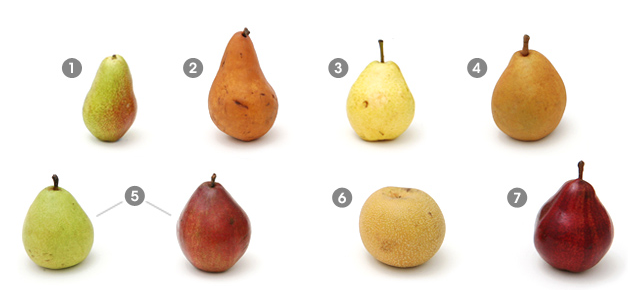The cache can be found at:
N 41 Bartlett Asian . Watermelon Watermelon Bosc
W 93 Taylor’s Gold Taylor’s Gold. Asian Bosc Bosc
Use this as your guide! 
Types of Pears
Forelle: This pear is easy to identify due to its small size, an ovalish shape, smooth skin, and striking yellowish-green freckled skin, which turns a beautiful red as it ripens. Sweet and delicate, Forelles are an old European variety. Because of their sweetness and size, Forelles are a good fruit choice for young children's snacks.
Bosc Pears: The Bosc pear stands a head taller than other pears with its elongated slender neck. Its brown skin has a relatively rough texture and can have hints of yellow or green. The pear's white flesh is sweet, crisp, and firm to the touch. If a recipe calls for poaching, Bosc pears are a good choice since they will keep their shape and not turn to mush. They're also good for eating raw and baking.
Bartlett Pears: Pictured is a fully-ripened yellow Bartlett; red Bartletts are also common throughout the U.S. Other than a difference in color, the two varieties share many qualities: a delicate thin skin, a sweet taste, and a bite that's juicy and soft. The Bartlett is an old pear variety, first developed in the late 1700s in the United States. Bartletts used to make up most of America's pear production (they have since given way to Anjou and Boscs), and they are still the most popular variety in the country. Most canned and processed pears (purées, juices) are made from Bartletts.
Taylor's Gold Pears: Related to the Comice pear, this large New Zealand pear is almost round and has a golden-brown skin. Its sweet juicy flesh is so smooth that it almost melts in your mouth. This is a good pear for making jams, jellies, and sauces.
Anjous Pears-Of the two types of Anjou pears, the green is easier to find, although red Anjous are gaining ground. Short, squat, and very plump, these pears look as if they almost have no neck—giving them an egglike appearance. Both varieties have a smooth skin with flesh that's juicy and firm. Green Anjous stay green, even when fully ripened. These are best eaten raw.
Asian Pears: This apple-shaped pear is unusual in many regards. First, it has a very unpearlike shape. Second, the skin's texture is a little gritty and not as soft as that of other pears. Third, the flesh isn't especially juicy (relatively speaking) and has a crispness that borders on crunchy. Fourth, it lacks a typical "pear" flavor. And finally, unlike many fruits, the Asian pear is ripe when it's firm, not when it becomes more pliable to the touch. Take advantage of the Asian pear's characteristics by eating it raw and in salads and slaws.
Red Comice: Pictured here is a red Comice, a variety of Comice pears that is still relatively new on the market (first found in the orchard in the 1970s). Like the Anjou, the Comice is also available in green. Both red and green Comice pears have skin that breaks very easily, and they are very sweet, creamy textured, and juicy. It's popular in holiday gift fruit baskets, so it has become known as the "Christmas pear." These pears aren't ideal for poaching because of their relatively delicate nature and juiciness, but they're great for baking and eating with cheese. Highly prized by the French, enjoy this pear with a good French Brie or another soft creamy fromage.